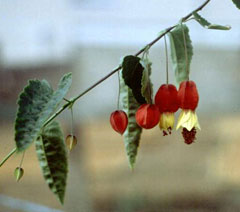
Trailing Abutilon
Latin Name: Abutilon megapotamicum
USDA Hardiness: 7-10
Native Range: Coming Soon
Edibility Rating: 4 / 5
Medicinal Rating: 0 / 5
Region:
Family:
Plant Type:
Medicinal Uses
Edible Uses
Edible Parts: Flowers | Edible Uses: Flowers - cooked. Used as a vegetable[183]. A pleasant sweet flavour, we find them delicious to eat raw[K]. The flowers are produced from mid spring until the autumn - they produce nectar all the time they are open so, assuming the plant is grown indoors and is not visited by pollinating insects, the sweetness increases the longer the flower is open[K].
Cultivation
Requires a sunny position or part day shade in a fertile well-drained soil[200]. Dislikes drought[200]. This species is only hardy in the mildest areas of Britain, tolerating temperatures down to between -5 to -10°c when given the protection of a south or south-west facing wall[11, 184, 200]. A deep mulch in winter and tying in growth to the wall will maximise protection in winter[200]. If the plant is cut back by cold weather, it will normally resprout from the base in the spring and can flower on the current year's growth[202]. Dead-heading plants to prevent seeding can enhance longevity[200]. Tip-prune young plants to promote a bushy habit, older plants can be cut back hard annually in spring if required[200]. There are some named forms, selected for their ornamental value[200]. There is a variegated form in cultivation, this variegation is as a result of infection by abutilon mosaic virus[184, 200]. Plants in this genus are notably resistant to honey fungus[200].
Known Hazards
None known
Habitats
Widely cultivated in the Tropics and not known in a truly wild situation.
